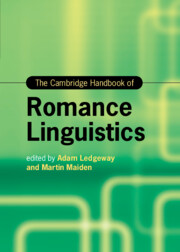Book contents
- The Cambridge Handbook of Romance Linguistics
- Cambridge Handbooks in Language and Linguistics
- The Cambridge Handbook of Romance Linguistics
- Copyright page
- Dedication
- Contents
- Figures
- Tables
- Contributors
- Abbreviations
- 1 Data, Theory, and Explanation: The View from Romance
- Part One What Is a Language?
- Part Two Phonetics and Phonology
- Part Three Morphology
- 10 Phonological and Morphological Conditioning
- 11 The Autonomy of Morphology
- 12 Suppletion
- 13 Inflexion, Derivation, Compounding
- 14 Evaluative Suffixes
- 15 Counting Systems
- Part Four Syntax
- Part Five Semantics and Pragmatics
- Part Six Language, Society, and the Individual
- Index
- References
13 - Inflexion, Derivation, Compounding
from Part Three - Morphology
Published online by Cambridge University Press: 23 June 2022
- The Cambridge Handbook of Romance Linguistics
- Cambridge Handbooks in Language and Linguistics
- The Cambridge Handbook of Romance Linguistics
- Copyright page
- Dedication
- Contents
- Figures
- Tables
- Contributors
- Abbreviations
- 1 Data, Theory, and Explanation: The View from Romance
- Part One What Is a Language?
- Part Two Phonetics and Phonology
- Part Three Morphology
- 10 Phonological and Morphological Conditioning
- 11 The Autonomy of Morphology
- 12 Suppletion
- 13 Inflexion, Derivation, Compounding
- 14 Evaluative Suffixes
- 15 Counting Systems
- Part Four Syntax
- Part Five Semantics and Pragmatics
- Part Six Language, Society, and the Individual
- Index
- References
Summary
This chapter highlights how phenomena found in modern Romance varieties as well as processes of language change pose challenges to the idea that inflexion, derivation, and compounding may reside in distinct modules or components of the grammar. It discusses the basic and uncontroversial characteristics of inflexion, derivation, and compounding with data from Romance languages and presents specific topics and case studies that challenge the traditional view from both a synchronic and a diachronic perspective. The first case study considers the ways in which various morphophonological alternations, such as diphthongization and palatalization, pattern alike or differently with respect to inflexion, derivation, and compounding. The question whether inflexion and derivation can be distinguished on semantic grounds is the focus of two further case studies dealing with (i) the formal marking and the semantic interpretation of number in Italian ambigeneric nouns, and (ii) with the different outcomes of the Latin augment /-sc-/ in modern Romance languages, which evolved in some languages into an inflexional marker, while retaining a derivational function in others. A final topic covered is so-called ‘conversion’, defined here as a transpositional (i.e., category-changing) process that is not marked by any formative, and thus applies to fully inflected words.
Keywords
- Type
- Chapter
- Information
- The Cambridge Handbook of Romance Linguistics , pp. 400 - 433Publisher: Cambridge University PressPrint publication year: 2022

